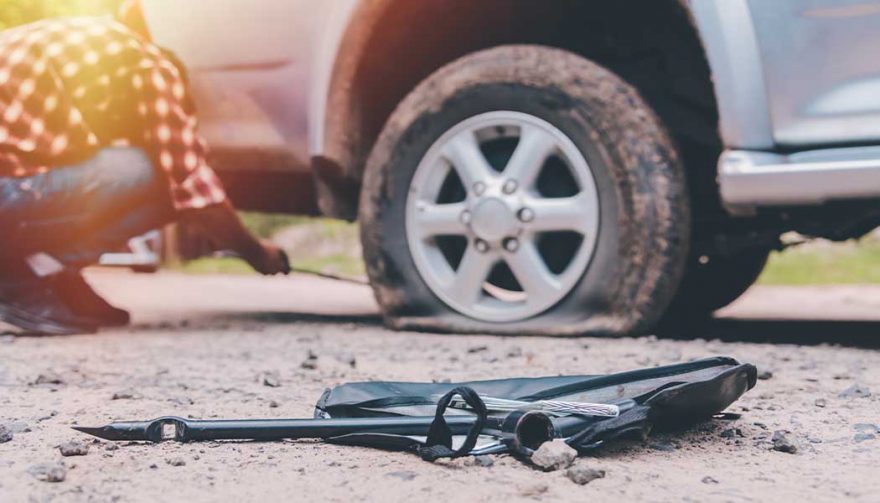
How to Change a Flat Tire Without an AAA Card
Your Guide on How to Change a Flat Tire
Thanks to improved tire technology, you are less likely to experience a flat tire than you would have a couple decades ago. With that said, Murphy’s law is still alive and well and that means you will have a flat at some point and it will occur at absolutely the worst time. If you have AAA or another roadside service, it is simply a matter of pulling over and making a call. But what if AAA says it will be two hours before they can get to you, you do not have a service, your phone battery is dead, or there is no signal? Do you even have a clue about how to change a flat tire?
Knowing how to change a tire is one of those pieces of automotive lore, like checking the oil, that every driver should have at least a passing knowledge of. In the best of circumstances, a flat tire will be an inconvenience. In the worst, it can be downright dangerous. So, we have put together a little primer that will hopefully refresh your memory.
What to do Before the Tire Goes Flat
Remember how we said flats will come at the most inopportune time? Well, that means it might be dark, raining, snowing, or on an interstate full of semis going 75 miles per hour. It’s best to know the basics about changing a tire before you need to do it.
Locate the Spare and Jack
If you are driving the typical Sedan or Coupe, the spare is in the trunk in a compartment under the carpet. Take the time to eyeball that little donut and test the tire pressure to ensure it is actually inflated. Most jacks now are the scissor type with an attached lug wrench. If you have never used one, take it out and familiarize yourself with it. If you drive an SUV, you most likely will have the same setup in the cargo area. There are exceptions like Hyundai Santa Fe, Mitsubishi Outlander, and other SUVs that pack a full-size tire. These might be in a compartment in the cargo area or mounted externally on the rear door.
Add Some Helpful Equipment
When your tire goes it will always be dirty, maybe muddy, or slippery if it is raining. It will be a mess to manhandle. Toss in a pair of work gloves to make the job easier. Include a piece of scrap lumber that you can use as a wheel chock during the tire change. Toss in a battery-powered lantern and a cheap warning reflector to make it safer.
Locate the Lift Points
Refer to your owner’s manual to locate the strong points on the frame where you can use the jack. Once you have those identified, physically check them out so it is not a mystery to you when you actually need them.
A Word About the Donut Spare
These became popular because they are significantly cheaper than a full-size spare, take up less space, and are not nearly as heavy. They are not replacement tires. Donuts are designed to get you to a place where you can get your flat repaired and that is it. They are structurally weak and typically have little or no tread. They are good for about 70 miles and you should not go faster than 50 miles per hour on a donut.
Changing a Flat Tire Step by Step
Punctures are the most common cause of flats. You might think you have one when the steering or braking becomes sluggish. You will know for sure when you hear that flap, flap, flap sound of rubber smacking the pavement. So, here is what you do:
Step 1: Find a Safe Place
Don’t panic, but do quickly find a safe place to pull off the road. A built-up area parking lot might be your best bet. At night, try to find a street light. If you are pulling off a roadway onto the shoulder, make sure you are far enough off the road that you will not get picked off by passing traffic. Turn on your emergency flashers, and if you have it, deploy your warning deflector.
Step 2: Remove Your Spare and Jack
Once you have located the flat, remove your spare, jack, and if you have one, your wheel chock. Place the jack and spare close to the flat. Put the wheel chock in front of the tire that is opposite the flat to keep the vehicle stable.
Step 3: Remove the Flat
Using the lug wrench from the jack, remove the hub cap or wheel cover (so old school) to get access to the lug nuts. Use the wrench to loosen the lugs. Don’t remove them, just loosen them so you can remove them with your fingers once the wheel is jacked up. Locate the appropriate lift point on the frame and place the jack under it. Use your hand to crank the scissors up until they make contact with the lift point. Take the lug wrench and use it as a jack handle to take the frame up far enough so there is 3 to 4 inches of clearance under the flat. Using your fingers, unscrew the lug nuts on the flat (donot lose them). Grabbing the flat (gloves come in handy here), carefully remove the flat and set it aside.
Step 4: Install the Spare
Lift the donut (this is the one time you will be happy the spare is not full-size) and line it up with the lugs. Install it by moving the donut directly onto the lugs. Finger tighten all the lug nuts on the donut. Use the lug wrench to lower the jack and complete the process by hand once the spare hits the ground. Using the lug wrench, tighten the lug nuts to ensure a tight fit.
Step 5: Tidy Up
Put your jack, lug wrench, wheel chock, reflector, and gloves back in the trunk compartment it was originally stored in. Your flat is not going to fit in there. Store it in the trunk or cargo space. Turn off your emergency lights, turn on your turn signal, and proceed to a repair shop remembering the donut is good for 70 miles at 50 miles per hour. If there is no shop open, head for home and use your second car or a friend’s car to haul the flat to the shop when it is open.
And that’s all there is to it. Here’s hoping you never have to go through it!





